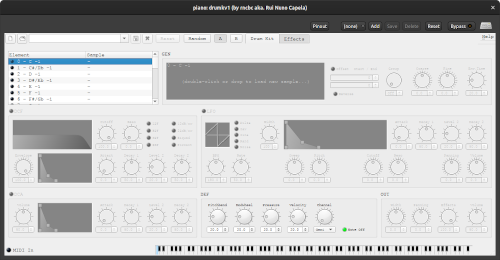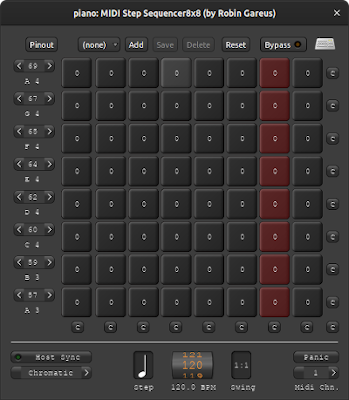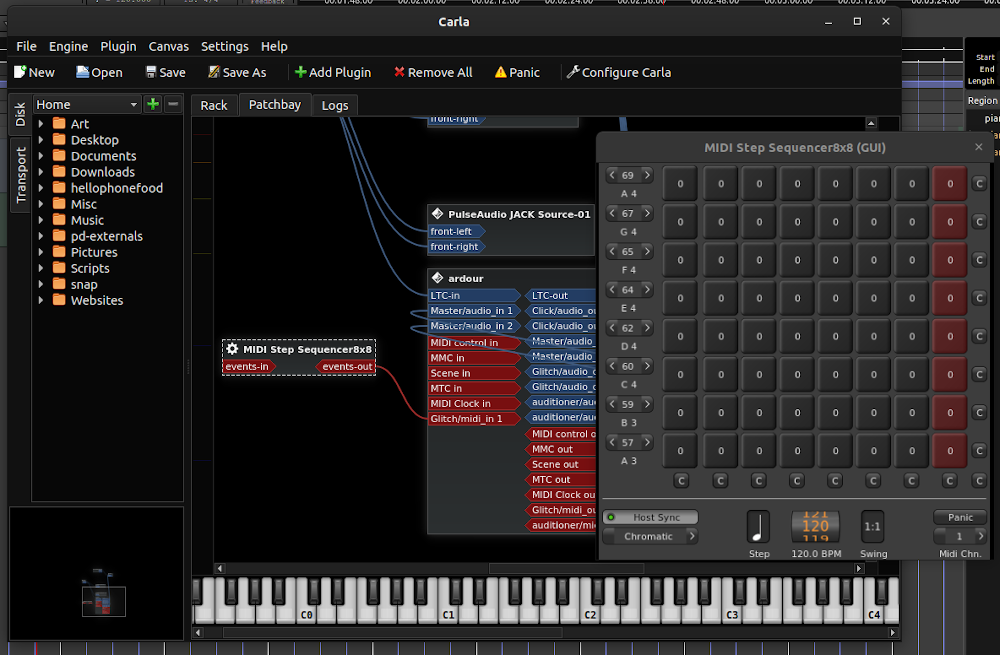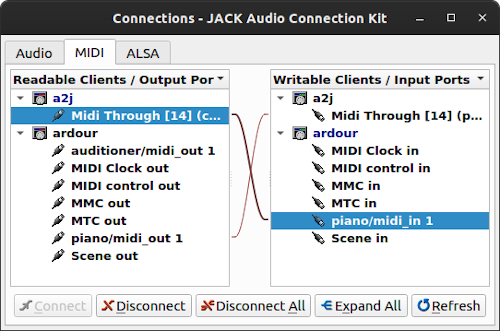For the majority of my career in art I’ve been primarily known for my visual artwork. I’ve dabbled in making noises with my Sonification Studies performances (which may make a comeback at some point) but it’s only since my 2018 performance at databit.me that I’ve regularly made and performed music.
On the performance side I’ve mostly used TidalCycles. You may have seen that I have been doing live streams of my rehearsals.
Outside of live coding I’ve spent most of my time getting to grips with software-based synthesisers and DAWs. When asking for advice on this most people told me to use software like Ableton. What these well-meaning people may not realise is that I exclusively use (Ubuntu) Linux and only open source software. This gives me the freedom that open source grants me but boy does it sometimes cause headaches! Plenty of people use the open source options available to them but this approach is still the road less travelld and so I’ve found myself sometimes asking lots of questions and either not getting a response or getting the response that what I’m trying to achieve is not possible.
And so for the last year or so that I’ve creating workflows that work for me. For this I’ve been using Ardour, which is a pretty good cross-platform DAW. So far I’ve produced soundtracks to two of my artworks, We Are Your Friends and Let’s Never Meet. In this Development Update I’ll go over a little trick I learnt whilst making the soundtrack for Let’s Never Meet.
In short, Let’s Never Meet is about meeting people over the internet. The soundtrack is actually a remix of a an Android alarm ring tone.
It’s not an alarm tone that I use myself but it was ambient enough to work in an outdoor setting for an extended period without getting annoying. Plus using a sample from my phone just somehow felt appropriate, if you know what I mean. After many many many hours of producing my remix sounded a bit like this:
I was really happy with the results but it felt like there was something missing. It was pretty samey throughout and I think there needed to be some kind of buildup or change in pace. To address this I decide to add some percussion. I turned to the glitch sample set that is downloaded when you install TidalCycles. It has a nice percussive quality and definitely sound glitchy and electronic, again in fitting with the digital theme of the piece.
As far as playing these samples I did consider manipulating them in TidalCycles and importing the whole recording file into Ardour, but I also wanted to get better with Ardour so sought a solution within that software. The glitch pack contains eight samples and I needed to be able to load them into Ardour to trigger/play at will. The drumkv1 plugin is the perfect solution to this.

It’s a sampler where you assign samples to midi notes. To play the notes you could use a midi keyboard, send the notes from Pure Data, or basically any software that can send midi. I decided to use the x42 step sequencer to input the midi notes. It’s a very simple step sequencer originally built for the MOD platform but, because it’s an lv2 plugin, it can run in any host that supports it.

Using this sequencer I could easily create an eight-step loop that starts simple builds up with more drums over time.
With the samples assigned to midi notes I just needed a way to press the pads in the step sequencer. I have two physical controllers, a Launchpad X and a MPK Mini. The latter only has two rows of four drum pads. The former is an 8×8 grid but I can’t yet program it properly to work with the software I use (more on that another time). In any case, in looking into how to use the Launchpad X with x42 the plugin’s author, Robin Gareus, told me that it’d never be possible because x42 doesn’t accept midi input 🙁
I accepted that using a software or hardware midi controller was a no go. I would have to use a mouse, which wasn’t ideal but it would work. The plugin’s author did recommend that I look into BSequencer. It appears to accept midi input but with a deadline looming I didn’t want to spend more time on this by learning yet another software.
Using my mouse in Ardour I started to record the input of me playing the step sequence but I noticed the midi notes from x42 weren’t being recorded.
I found this very strange. drumkv1 was blinking to show it was receiving midi but nothing was being recorded. After some research I discovered that it was because Ardour records external midi. When I loaded x42 as a plugin within Ardour it was sending midi internally. To get around this there are two solutions:
I used Carla as a plugin host to load x42 and then sent the midi output to the correct track in Ardour.

This worked but I was getting a lot of latency with the input and the notes didn’t align properly. This is probably easy to solve by tuning my system to reduce latency (I already use the realtime kernel), or maybe something that I was doing wrong, but again with a looming deadline I didn’t want to do anything drastic and time consuming.
The second option was to send the output of x42 out into another application and then have that external application send its midi input into Ardour. To do this I loaded a2jmidid, connected the track’s midi output into it, and then connected the output of a2jmidid into the track in Ardour.

When I started up x42 again in Ardour and started clicking on its pads it all worked as expected!
After all of that effort I recorded myself building up the percussion. Here’s the finished track 🙂
I’ve been having a lot of fun making music, so expect more of it from me in the future.
